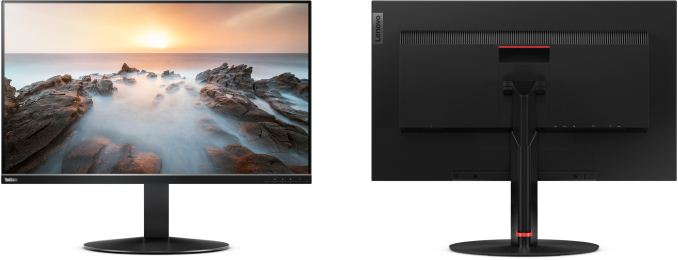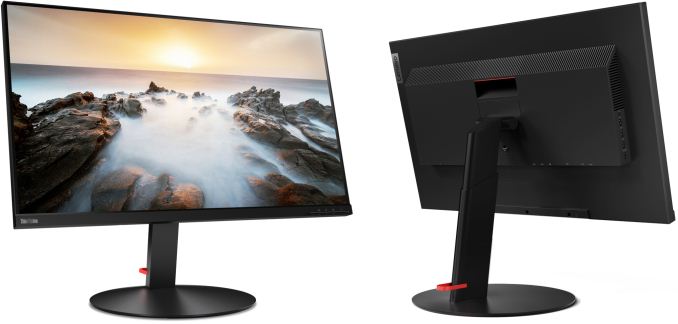Lenovo Announces ThinkVision P32u LCD: 32-inch, 4K, TB3 with Daisy Chaining
by Anton Shilov on January 4, 2018 12:02 AM EST
Ahead of CES, Lenovo is introducing its new ThinkVision P32u professional-grade display. The latest monitor from the company offers an Ultra HD resolution, a wide color gamut, as well as Thunderbolt 3 with daisy chaining, allowing users to to connect further TB3 devices and monitors downstream of the P32u.
Like most professional displays nowadays, the ThinkVision P32u is equipped with an IPS panel featuring an antiglare coating. The latter measures 32”, has a 4K UHD (3840×2160) resolution, a 300 nits brightness, a 1000:1 contrast ratio, a 6 ms GtG response time, 178°/178° viewing angles as well as a 60 Hz maximum refresh. The monitor covers 99.5% of the AdobeRGB color space, which means that its capabilities exceed those required to display 100% of the sRGB spectrum. The company also notes that the monitor supports a “multi-color space capability”, but it's not clear right now whether that capability means that the monitor can display content in different color spaces simultaneously side-by-side in PBP/PiP modes (like some other professional displays), or whether it means something else entirely.
The specs of the ThinkVision P32u hardly look special for a professional monitor as there are numerous 4K models with 99% AdobeRGB coverage for designers and photographers these days. Moreover, its brightness and contrast may be considered too low by the target audience. The key feature of the Lenovo ThinkVision P32u appears to be its connectivity. In addition to the usual DisplayPort 1.2 and HDMI 2.0 inputs, the new monitor has a Thunderbolt 3 input and a Thunderbolt output that can be used to daisy chain another ThinkVision P32u (or a different TB3-enabled monitor), a high-end external storage sub-system, or any other TB3 device. While the Thunderbolt 3 technology has been on the market for 2.5 years now, the number of displays supporting TB3 daisy chaining is limited, so the feature will be an indisputable trump of the ThinkVision P32u. Meanwhile, Lenovo does not forget about widespread USB Type-A peripherals and the new display features a quad-port USB 3.0 hub (one connector supports charging).
When it comes to physical features and ergonomics, the ThinkVision P32 has rather thin bezels and comes with a detachable stand that offers height, tilt, swivel and pivot adjustments along with a red cable management bracket.
| Specifications of Lenovo's ThinkVision P32u Display | ||
| ThinkVision P32u | ||
| Panel | 32" IPS | |
| Native Resolution | 3840 × 2160 | |
| Maximum Refresh Rate | 60 Hz | |
| Response Time | 16 ms | |
| Brightness | 300 cd/m² | |
| Contrast | 1000:1 | |
| Viewing Angles | 178°/178° horizontal/vertical | |
| Pixel Pitch | 0.1845 × 0.1845 mm | |
| PPI | 137 | |
| Color Gamut | 99.5% AdobeRGB 100% sRGB (?) |
|
| Inputs | 1 × DisplayPort 1.2 2 × HDMI 2.0 1 × Thunderbolt 3 input 1 × Thunderbolt 3 output |
|
| Audio | 3.5-mm headphone jack | |
| Color | Black and grey | |
| Power Consumption | Standby | unknown |
| Typical | 70 W | |
| Maximum | 200 W (possibly when upstreaming power to a powerful laptop + charging a smartphone using a USB port) | |
Lenovo plans to start selling its ThinkVision P32u display in March for $1349.
Related Reading
- Lenovo Launches New ThinkPad Accessories: Docking And Displays
- LG Announces the 5K UltraWide 34WK95U: A 'Nano IPS' Monitor with a HDR600 Badge
- LG Develops ‘Nano IPS’ LCD, Unveils 32UK950 4K Display with DCI-P3, HDR600, TB3
- BenQ Launches the SW271 Display for Professionals: 27-inch 4K with HDR and DCI-P3
- Philips Demos 328P8K: 8K UHD LCD with Webcam, Docking, Coming in 2018
- Lenovo Announces New ThinkStation P520/P520C and ThinkPad 52s: Up to 18 Core Xeon-W, Quadro Graphics
- Lenovo Launches Yoga 920 Convertible: 13.9” 4K LCD, 8th Gen Core i7, TB3, 3 Pounds
- Lenovo Unveils ThinkStation P320 Tiny SFF Workstation
- Lenovo Updates ThinkStation P320 with Intel Xeon E3 v6 and NVIDIA Quadro Pascal


















29 Comments
View All Comments
Inteli - Thursday, January 4, 2018 - link
Because most work was still done on pen and paper. The 60's was before even pocket calculators were a thing. Computers weren't used for most things we use computers for today, so a basic display was wholly sufficient.We all understand that higher refresh rates are better than lower refresh rates, but this monitor doesn't *need* high refresh rates, and a high refresh rate panel and the controller to drive it would needlessly add to the cost of an already expensive monitor.
gerz1219 - Thursday, January 4, 2018 - link
Video professionals are staring at a static image 95% of the time they're working. Most videos are still at 30 or 24 fps, so technically even 60Hz is an unnecessary luxury for playback in most video workflows. Higher refresh rates only benefit gamers. For years now, Anandtech has been featuring writeups for monitors aimed at video professionals, and gamers have to complain that the refresh rate is too low and there's no G-Sync.You don't see video professionals complaining that gaming monitors don't allow for hardware calibration.
p1esk - Thursday, January 4, 2018 - link
I'm not a gamer. I'm someone who tried using 120Hz monitor (for coding and browsing).gerz1219 - Thursday, January 4, 2018 - link
Okay, but you're not a colorist, an editor, or a motion graphics artist. For coding and browsing, you'd probably be much better served by a nice gaming panel with a high refresh rate -- that way you could play games on it when you're not coding or browsing. Colorists can't use a gaming panel for work.billybeer321 - Thursday, January 4, 2018 - link
Please point us all to a monitor that can do 4k at more than 60 Hz. Let alone a connector/pipeline on a video card that can supply the bandwidth required. It's 2018 and neither of those things exist yet, so keep waiting.DanNeely - Thursday, January 4, 2018 - link
Displayport on the current generation of AMD/NVidia cards supports 4k 120hz without compression. 4k 144 requires compression.DanNeely - Thursday, January 4, 2018 - link
The first 4k 144 monitors were supposed to be out last summer, but AUO's been struggling to get them into production. If nothing else has slipped since November they should be out in the next month or two.OTOH AUO historically hasn't produced panels with colors and backlight levels as consistent across the panel as their competition; so those panels probably wouldn't make it to anything aimed at graphics professionals anyway.
Beaver M. - Friday, January 5, 2018 - link
Is that surprising you? AUO is even struggling with production of established products. From own experience, their usable percentage of panels is maybe 1-10%. The rest is just garbage, but they still throw them on the market, because there are enough uncritical people who wont even notice a dozen dead pixels or backlight bleeding that would bother Stevie Wonder.neo_1221 - Thursday, January 4, 2018 - link
Are there any monitors that can do 4K at >60hz?Pinn - Thursday, January 4, 2018 - link
wide color? So 10-bit without those funky nit specs? I have one of these that does 10-bit, but doesn't look much different. you need the nits, bro.